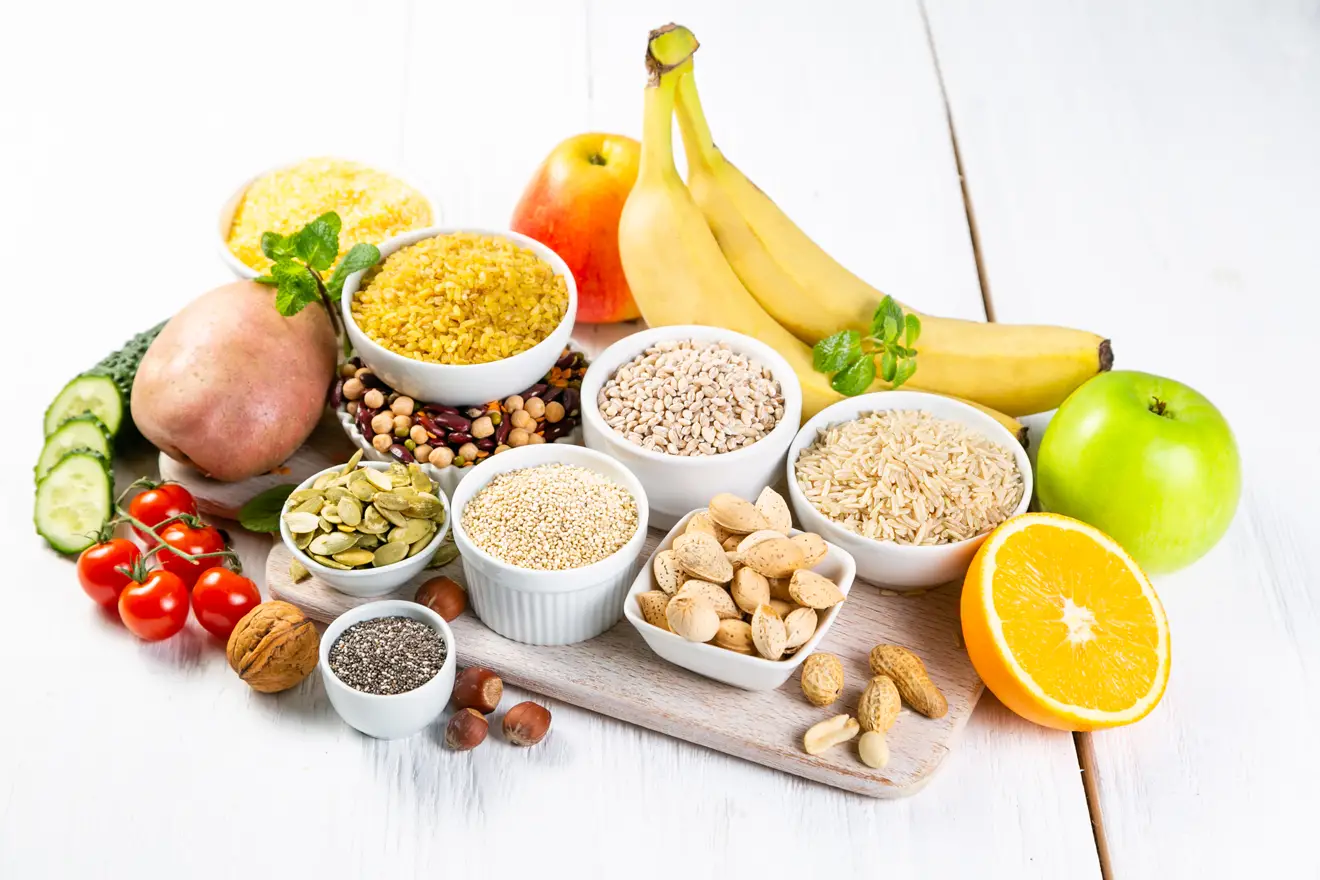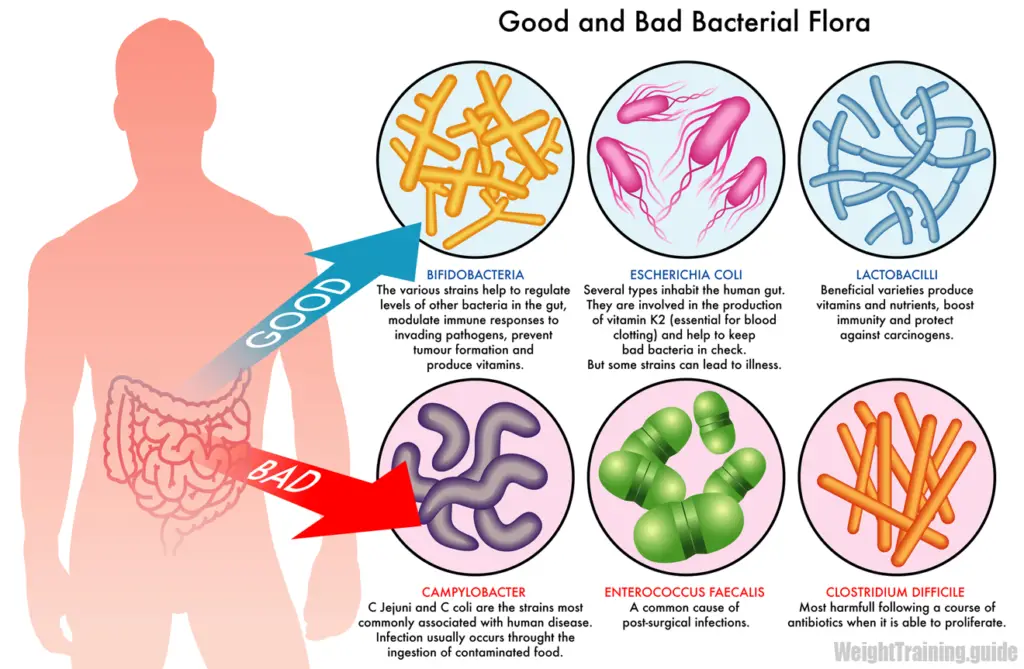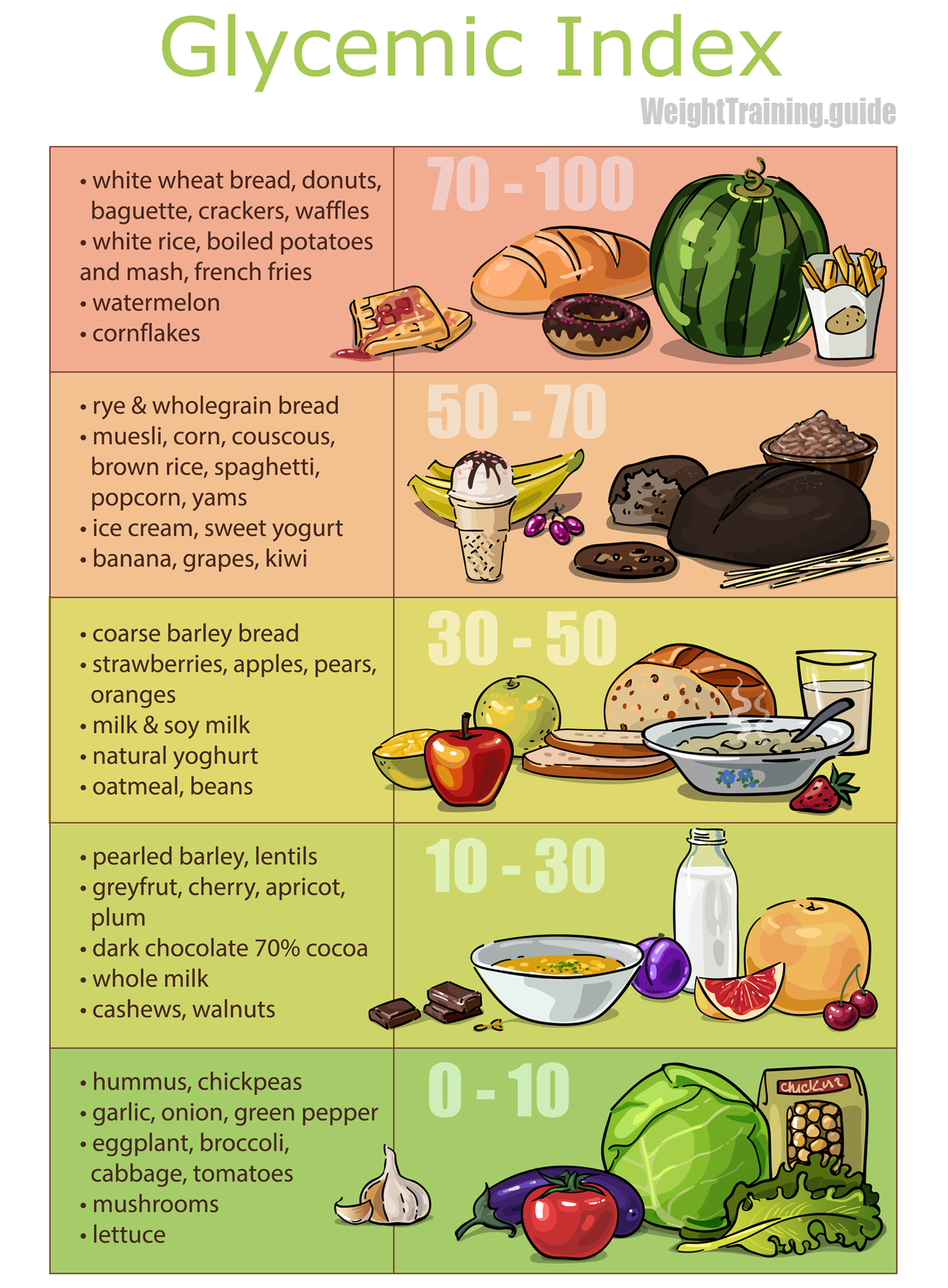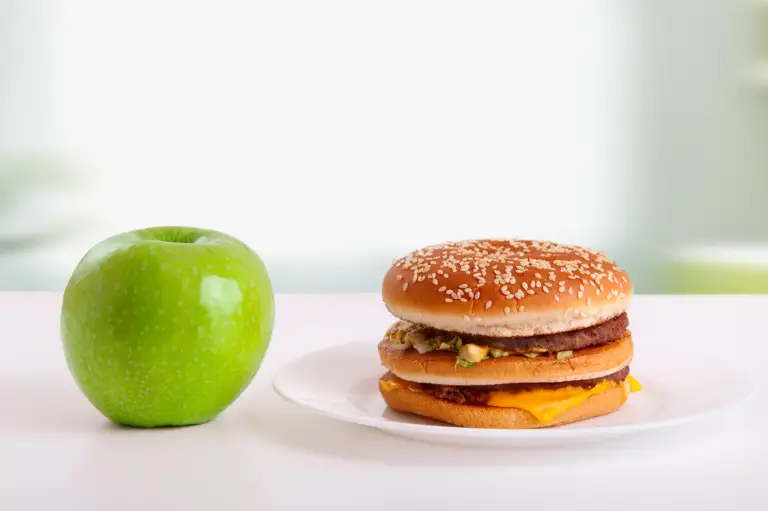Carbohydrate and dietary fiber
Why is carbohydrate important for weight training?
Carbohydrate is your body’s main source of fuel. Generally speaking, when you eat carbohydrate, the digestible parts are broken down into the sugar glucose, which provides energy for the cells of your body. Any remaining glucose is stored in a form known as glycogen in your liver and in muscle cells for later use. If glycogen stores are full, excess glucose is stored as fat. All of this means that, if you don’t consume enough carbohydrate, your workouts (and therefore your gains) will be compromised. You’ll fatigue sooner when you train, and your muscle and strength gains will be reduced. Conversely, if you regularly eat too much carbohydrate, the excess will be added to your waistline (men) or hips, butt, and thighs (women).
Since carbohydrate stimulates the release of insulin, it’s also important for building muscle. Insulin allows amino acids and glucose to enter muscle cells, where they can be used for energy, muscular repair, and muscular growth. Without insulin, your muscle cells will not be able to use amino acids or glucose.
Another way in which carbohydrate affects muscular development is through its effect on testosterone and cortisol (a stress hormone that is associated with muscle breakdown). Low-carbohydrate diets are known to decrease the level of testosterone and increase the level of cortisol.
Types of carbohydrate
There are four types of carbohydrate, which are classified based on their molecular complexity:
- Monosaccharides
- Disaccharides
- Oligosaccharides
- Polysaccharides
Monosaccharides and disaccharides are known as simple carbohydrates or sugars, whereas oligosaccharides and polysaccharides are known as complex carbohydrates.
Monosaccharides (‘single sugars’) are the most basic units of carbohydrate. They cannot be broken down any further and include glucose (also known as dextrose), fructose (fruit sugar), and galactose (found in dairy products). Monosaccharides are the building blocks of disaccharides, oligosaccharides, and polysaccharides.
Disaccharides (‘double sugars’) are formed of two monosaccharides. They include sucrose (table sugar), maltose (malt sugar), and lactose (milk sugar).
Oligosaccharides (‘a few sugars’) are composed of three to ten monosaccharides. The more complex oligosaccharides cannot be digested by the body and therefore act as fiber. Fiber, as described in more detail below, is any plant-based food material that cannot be fully digested.
Oligosaccharides offer a variety of health benefits, including helping to feed ‘friendly’ bacteria (known as probiotics; Figure 1) in the large intestine. These kinds of oligosaccharides are known as prebiotics. Two common oligosaccharides are raffinose and stachyose, which are found in beans and other legumes. As probiotics break them down, the gas for which beans are famous is produced.
Figure 1. A few of the ‘good’ and ‘bad’ microorganisms of the human digestive tract, along with descriptions of the important roles they play in the body or the problems they can cause.
Polysaccharides (‘many sugars’) are chains containing more than ten monosaccharide units. Examples include starch, glycogen, cellulose, and chitin. Starch, which is composed simply of glucose, is the only digestible polysaccharide. It can be found in grains, root vegetables, and legumes.
Dietary fiber
Dietary fiber can be found only in plant products, such as nuts, whole grains, legumes, fruits, and vegetables (Figure 2). It can be defined as any plant-based food material that cannot be fully digested. However, despite being mostly indigestible, dietary fiber is still extremely important for your health, helping to reduce the risk of heart disease, cancer, infectious diseases, and respiratory illnesses, as well as promote healthy bowel movements (laxation). Fiber also aids weight loss by reducing food intake. This is because fiber-rich foods take longer to digest and therefore lead to an increased feeling of fullness and satiety.
Figure 2. Fresh fruits and vegetables, which are a great source of fiber.
There are two types of dietary fiber:
- Soluble
- Insoluble
Soluble fiber dissolves in water, swells, and forms a gel-like substance, some of which is digested and absorbed. The gradual absorption slows the entrance of glucose into the blood stream, thereby preventing large blood glucose and insulin spikes. Soluble fibers include pectins, gums, mucilages, and some hemicelluloses. Good sources of soluble fiber include oats, peas, beans, lentils, barley, fruits, and vegetables, especially carrots, apples, and oranges.
Insoluble fiber does not dissolve in water. It passes through your digestive tract in close to its original structure, which adds weight and size to your stool and therefore aids bowel movements. This offers many benefits to intestinal health, including a reduction in the risk of hemorrhoids and constipation. Insoluble fibers include cellulose, lignins, and some hemicelluloses.
Most insoluble fibers come from the bran layers of cereal grains. Whole-wheat flour, whole grains, wheat bran, and brown rice are full of insoluble fiber. It can also be found in the seeds and skins of fruits, so always eat your peels.
As published in the Dietary Guidelines for Americans, 2020–2025, the USDA recommends a fiber intake of 28 grams per day for women aged 19 to 30, with the amount dropping to 22 grams per day after the age of 51. As to men aged 19 to 30, the USDA recommends a fiber intake of 34 grams per day, with the amount dropping to 28 grams per day after the age of 51. This should include a combination of both soluble and insoluble fiber. In the USA, more than 90 percent of women and 97 percent of men do not meet recommended intakes for dietary fiber, making the lack of fiber intake a serious public health concern. You can increase the amount of fiber that you ingest by making simple changes to your dietary habits, such as:
- Choosing whole fruits and vegetables instead of juices
- Consuming fruits and vegetables without peeling them (if possible)
- Choosing whole-grain breads, cereals, and pastas over processed and refined varieties
- Choosing goods made with whole-wheat flour instead of white flour
- Swapping white rice for brown rice
- Occasionally replacing meat with beans or other legumes
What are the best sources of carbohydrate?
The best sources of carbohydrate are nutrient-dense and fiber-rich whole foods, such as whole-wheat breads and pastas, brown rice, porridge, sweet potato, legumes, fruits, and vegetables. Many individuals think it’s important to only eat carbohydrates that have a low glycemic index; however, that is unwise.
The Glycemic Index
The Glycemic Index (GI) is a measure of how rapidly a food containing 50 grams of carbohydrate will make your blood glucose level rise after consumption. Pure glucose has the highest GI of 100. All foods containing carbohydrate are given a score between 0 and 100 and are ranked as either low, medium, or high based on their score (Figure 3). Two foods with the same amount of carbohydrate can have different GIs. The higher the food’s GI is, the faster the carbohydrate content can be broken down and absorbed, causing a rapid increase in blood glucose.
Figure 3. High, medium, and low glycemic index foods.
Persistently high blood glucose levels or repeated blood glucose ‘spikes’ following meals may increase an individual’s chances of developing type 2 diabetes and coronary heart disease, which is why high-GI foods are generally not recommended. However, it’s important to note that the GI of a food is based on eating the food by itself. When eaten with other foods, the meal’s overall GI will be different. Combining high-GI foods with low-GI foods will balance out the effect on blood glucose levels. Fat, fiber, and acidic foods (such as lemon juice or vinegar) help to lower the GI of a meal. Other factors that may affect a food’s GI include:
- Ripeness — the riper a fruit or vegetable is, the higher its GI may be
- Processing — the more processed a food is, the higher its GI may be
- Cooking method — the longer a food is cooked, the higher its GI may be
Another important point to note is that many nutritious foods have a higher GI than do less nutritious foods. For example, wholemeal bread has a higher GI than a Mars bar has! Therefore, judging a food solely based on its GI isn’t wise and should be balanced with other principles of nutrition, such as moderating foods that have low nutritional value.
How much carbohydrate do you need per day?
The USDA recommends in the Dietary Guidelines for Americans, 2020–2025, that 45 percent to 65 percent of the daily kilocalories consumed by males and females of any age should come from carbohydrate. Since carbohydrate is your main source of fuel, the more active you are, the more carbohydrate you will need to fuel your activities. However, keep sugars to a minimum (less than 10 percent of your daily caloric intake).










